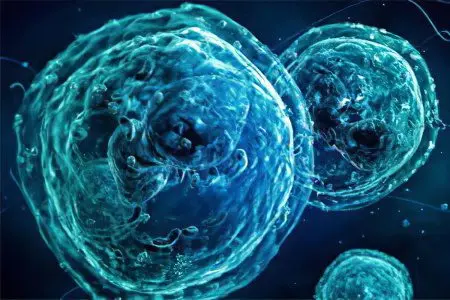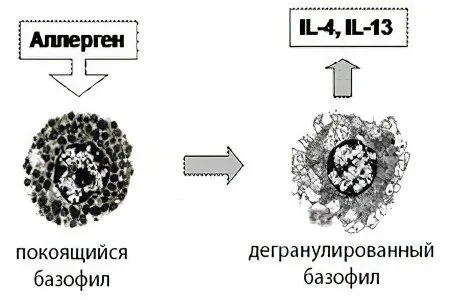Contents

Basophils are large granular white blood cells that are present in the blood in small numbers. They are responsible for the destruction of foreign agents in the human body. After formation, basophils exit the vascular bed into tissues. The duration of the existence of basophils is about 7 days; there is no reserve of them in the bone marrow.
Basophils produce histamine, as well as other substances that take part in blood clotting processes, in particular, heparin. Basophils also carry immunoglobulin E to receptors.
In tissues, basophils are present in the form of mast cells, often referred to as mast cells. There are many of them in the dermis, in the serous membranes, in the connective tissues that surround small vessels. Basophils also perform other useful and necessary functions for the body. At a time when they are not needed, the amount of basophils is equal to 0-1%, but if the body begins to need them, then their level rises significantly.
Low levels of basophils cannot be

Normally, the level of basophils in the blood of an adult is 0-1%. However, when a number of conditions occur, for example, with the development of an allergic reaction, the concentration of basophils increases dramatically.
In children, the level of basophils also always remains at a stable level, regardless of the age of the child. On average, these indicators equate to 0,5%, and in newborns they may be completely absent in the analyzes. Sometimes in an infant, the level of basophils can change several times even within one day, increasing during crying, with increased anxiety, with the introduction of complementary foods, with an increase in body temperature, etc. Therefore, the results should be evaluated by their absolute value. The basophil index should remain in the range from 0 to 0,09×109/l (0,09 Giga/liter).
A wide variety of conditions can lead to an increase in the level of basophils in the blood, from taking certain medications to an inflammatory reaction.
Possible reasons for the increase in basophils:
Hypersensitivity reaction.
Blood diseases: hemophilia, anemia, chronic myeloid leukemia, erythremia.
Viral diseases, such as influenza or chickenpox.
Vaccination.
Tuberculosis.
Iron-deficiency anemia.
Ulcerative colitis.
The presence in the body of a malignant tumor growing from epithelial tissue.
So, if the level of basophils is increased in the general blood test, then this may indicate infection of the body, which gives an inflammatory reaction. In addition, allergens are also capable of causing a jump in basophils. And sometimes it is very stormy, and a person develops anaphylactic shock at this time. In this case, the victim needs emergency medical care, or he will die.
Functions of basophils

Basophils are carriers of many substances that the body needs. They are involved in the transport of stimulating factors that are aimed at the production of a compliment, immunoglobulin E, cytokines. These cells are responsible for immediate type reactions, they are involved in the development of anaphylactic shock. In just a few seconds, a person may need emergency medical attention.
Basophils are responsible for the production of serotonin, heparin, histamine, proteolytic enzymes, prostaglandins and other biologically active substances. When pathogens enter the body, basophils quickly go to the right place and force all of the above substances to come out of their shells and “save” the human body (there is an expansion of capillaries, tissue regeneration, elimination of inflammation, etc.).
Basophils are responsible for the production of heparin, which prevents blood clotting and the formation of blood clots.
Basophils – friends or foes?
Basophils on their surfaces have areas that can bind not only immunoglobulins E, but also other substances akin to them. Such sites are called high-affinity receptors. They have the ability to attract antibodies that circulate in the blood. These antibodies are able to quickly “stick” to basophils and firmly fix on them. Eosinophils have the same receptors, so they can always be found in large numbers in those places where a hypersensitivity reaction occurs.

If we consider this process in the form of a diagram, then it will look like this:
Antibodies circulating in the blood are on the lookout for basophils. When they find suitable cells, they attach themselves to them and continue their journey in search of the antigens they need.
Antigens that enter the body get to the antibodies waiting for them.
They react with each other and can stick together. As a result, lgE aggregates are formed.
The receptors respond to these couplings by releasing a large number of basophils and mast cells, which cause the production of substances responsible for the immediate type of reaction.
At one point, histamine, serotonin and heparin are released from basophils, which contributes to the expansion of blood vessels at the site of inflammation. They become permeable, blood arrives at the site of the “catastrophe”, fluid begins to accumulate in the tissues, and edema forms. At the same time, basophils are not destroyed, they retain the ability to carry out their functions.
Such a reaction of the body, which is carried out with the help of basophils, can both protect the body and attract other immune cells to the site of inflammation.
This is where they start to trickle in:
Neutrophils that have phagocytic properties.
Macrophages and monocytes that destroy pathogens foreign to the body,
Lymphocytes that destroy antibodies or give rise to their production.
Antibodies.
However, such a violent reaction of the body is sometimes expressed not only in a slight edema, but in anaphylactic shock. After the action of serotonin and histamine ends (they are unable to “work” for a long time), the body continues to fight the infection using other mechanisms (due to cytokines, leukotrienes and other substances).
Signs of an anaphylactic reaction

An allergic reaction has the following manifestations:
Anaphylactic shock, which is the most severe form of allergy. In this case, the person loses consciousness, his blood pressure drops sharply. The victim needs emergency medical attention.
Suffocation, which is observed in asthmatic patients.
Allergic rhinitis, which is expressed by coughing and flow of mucus from the nose.
Skin rashes. A person develops hives.
Anaphylactic shock develops faster than other reactions, it is formed in just a few seconds. This can happen after an insect bite, after the introduction of drugs and not only. This condition is a direct threat to life. The subsequent anaphylactic reaction will be stronger than the previous one, since the antibodies in the blood are already circulating. It can be stopped with the introduction of adrenaline or glucocorticoids.









